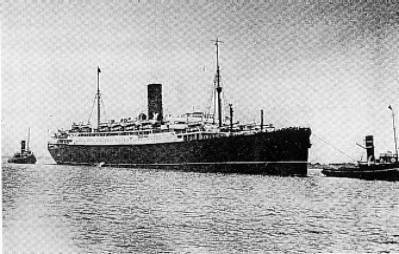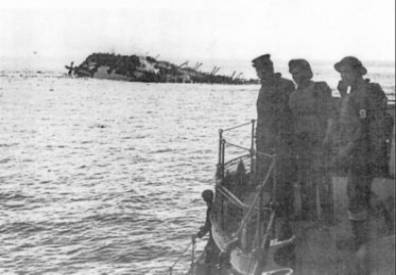
The Lancastria on the River Thames before the war
Shipwrecks
diving into history
The Worst
British Maritime loss ever -
HMT Lancastria
The Lancastria is the highlighted cruise liner this issue. As stated in the title the sinking of the Lancastria is the worst loss of life that Britain has ever suffered from one vessel and yet how many of you thought that dubious distinction belonged to the much-acclaimed Titanic?

The Lancastria on the River Thames before the war
This 16,243 ton Cunard liner was built by William Beardmore & Co, Dalmuir Glasgow, making her maiden voyage under the name of Tyrrhenia, from Glasgow to Montreal on 13 June 1922. Refitted just two years later with a plush new interior and a new name, Lancastria, she spent many years leisurely cruising the world’s oceans. Her final peace-time cruise in the idyllic waters of the Bahamas was made in September 1939, and ended with the ship docked in New York, and the world at war. Here she underwent a radical change - her portholes were blacked out, drab grey military paint daubed all over her and guns mounted near to the once splendid swimming pool! Her cruising days were over forever as she took on the role of one of Her Majesty’s troopships.
After
successfully dodging Luftwaffe bombs in the North Sea while helping with the
evacuation of troops from Norway the Lancastria
then took part in Operation Aerial where she was
required in St Nazaire, France, to evacuate more British troops.
At 04h00 on the 17 June 1940 she anchored slightly off St Nazaire at
Charpentier Roads and began evacuating soldiers from the British Expeditionary
Force along with some RAF men and a few civilians.
There were so many people to evacuate that the afternoon arrived and the
ferrying to and fro was still continuing. British
Reserve Naval officers had coordinated the embarkation of evacuees with Sharpe.
When the captain was asked how many troops his ship could take he replied
“3,000 at a pinch”. By mid afternoon counting had ceased at 4000 and still the
loading continued. There is no
accurate figure for the number aboard but it is estimated that there were over
7000 people. The Lancastria was literally overflowing.
Then the
bombing began. German Dornier Do17
aeroplanes flew overhead and, being trained for shipping attacks, were both
delighted and amazed to see the enormous cruise ship undefended and stationary,
just waiting for their arrival! It
nevertheless took the enemy planes almost 2 hours to strike the Lancastria.
Four bombs hit in total, one was a bull’s eye, dropping straight down
the funnel and exploding in the engine room.
At 16h15, less than 20 minutes later, the Lancastria
rolled onto her port side and made her way bow first to her grave on the seabed.
The crew and
passengers appeared not to panic while abandoning the sinking liner and
incredibly singing was heard as the ship went down (“roll out the barrel”
and “there will always be an England”!)
Many people perished but there were some survivors. Two lifeboats had
been launched and many had jumped overboard as the boat was swallowed up.
However, the constant presence of enemy aircraft made any rescue
operation very difficult. Also one
of the bombs had ruptured the Lancastria’s
fuel tank causing fuel oil to leak everywhere.
Pulling victims from the water was a very slippery affair
and often unsuccessful. Nobody
knows for sure how many lost his or her lives that day because nobody knows
exactly how many people were on board. Estimates
are that approximately 4500 or 5000 people died.
Thankfully around 2500 were rescued.
Rudolph Sharpe, the captain, was amongst those who were rescued. Although a well respected captain, having served on such grand vessels as the Mauritania and the Olympic (sister ship of the Titanic) he also seemed to attract more than his fair share of trouble. He was master of the Lusitania, leaving just before its fateful 1915 sinking. Then two years after surviving this ¾ Britain’s worst ever maritime disaster ¾ he was captain of the Laconia when it sank after being torpedoed by U156. Over 2,000 people lost their lives, including Captain Sharpe, making it the second worst British maritime disaster.

The
death throes of HMT Lancastria
On
the coast overlooking the site of the tragedy there are no grand memorials for
the dead of the Lancastria.
However, looking closely at a nearby signpost that points out over the
murky Loire estuary, a tourist’s hastily scratched “Lancastria
– this way” is revealed. Any of
you living or visiting London should try and visit the St Katherine Cree church
in Leadenhall Street, EC3. Here a
permanent memorial quietly adorns one of the windows.
There is also a HMT Lancastria Association (for survivors) but on the
whole the Lancastria lies forgotten
with 26m of water on top of her.